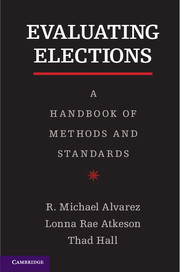Book contents
- Frontmatter
- Contents
- Acknowledgments
- Introduction
- 1 The Electoral Ecosystem
- 2 Easily Available Data for Performance Evaluation
- 3 Measuring the Experiences of Voters
- 4 Measuring the Performance of Poll Workers
- 5 Auditing the Election Ecosystem
- 6 Election Observation
- Conclusion
- Appendix: Precinct Opening, Closing, Election Day Forms
- References
- Index
4 - Measuring the Performance of Poll Workers
Published online by Cambridge University Press: 05 December 2012
- Frontmatter
- Contents
- Acknowledgments
- Introduction
- 1 The Electoral Ecosystem
- 2 Easily Available Data for Performance Evaluation
- 3 Measuring the Experiences of Voters
- 4 Measuring the Performance of Poll Workers
- 5 Auditing the Election Ecosystem
- 6 Election Observation
- Conclusion
- Appendix: Precinct Opening, Closing, Election Day Forms
- References
- Index
Summary
For a majority of voters in a majority of states, the voting experience involves going to a polling place – either in early voting or on Election Day – and casting a ballot. In that visit to the polling place, it is with the poll workers whom the voter interacts. As several authors have noted (e.g., Hall et al. 2007, 2008, 2009), poll workers are what are typically referred to as street-level bureaucrats. The term bureaucrat is not meant here as a pejorative; rather, it reflects that fact that, in a polling place, the poll worker makes an array of decisions that determine the experience that each and every voter has. Perhaps the most important decision a poll workers makes is whether a person is an eligible voter and whether she will get a regular ballot, a provisional ballot, or no ballot at all. Poll workers also determine whether to ask a voter to show identification – a decision that may or may not follow the state's law (Atkeson et al. 2010e). The ability of a poll worker to follow the directions and complete a provisional ballot form correctly may determine whether a voter's ballot gets counted. This is just part of a larger list of ways in which poll workers make decisions that directly affect the experience that voters have at the polling place and the general functioning and operations of the precinct.
- Type
- Chapter
- Information
- Evaluating ElectionsA Handbook of Methods and Standards, pp. 92 - 114Publisher: Cambridge University PressPrint publication year: 2012



